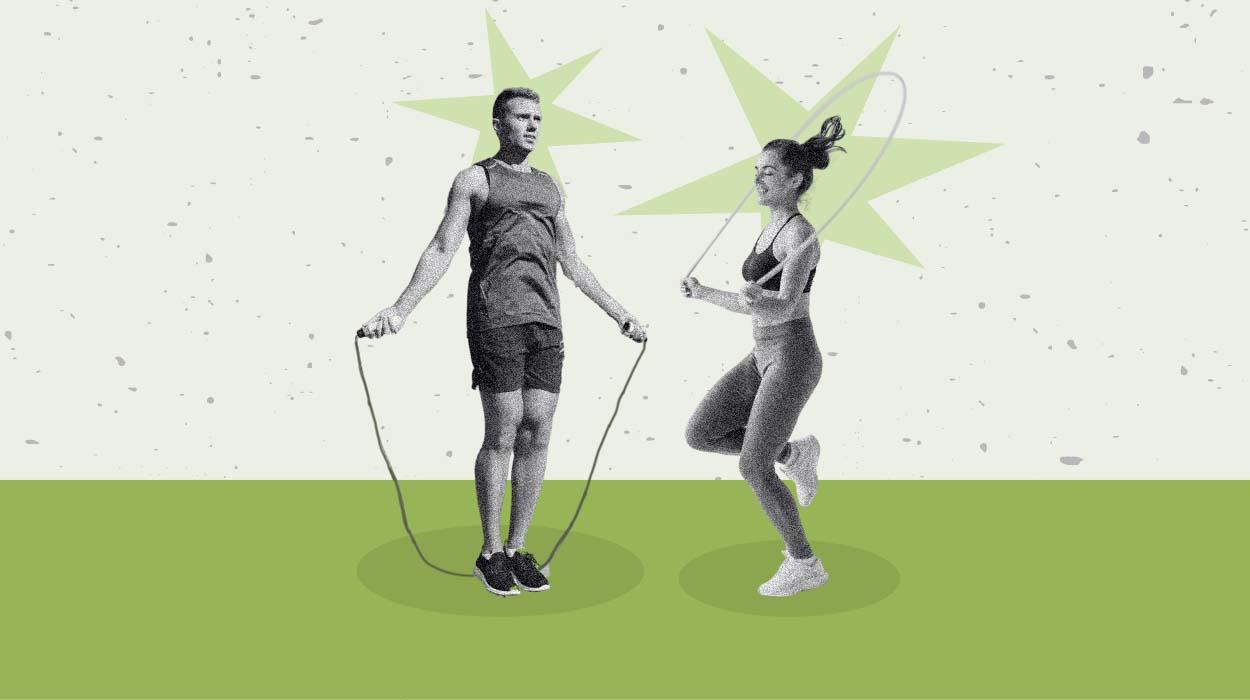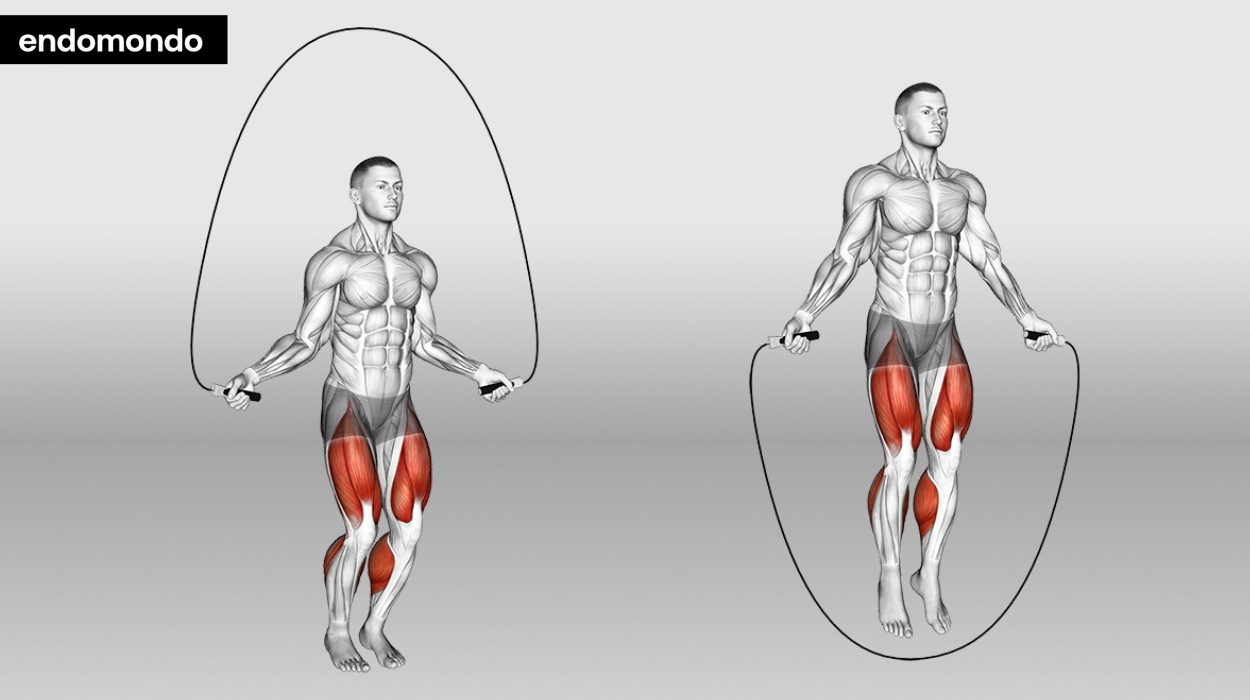
Not just youngsters can jump rope. Due to its versatility, the exercise is frequently utilized as a warm-up or even as a crucial component of a full-body workout routine itself. In this article, we will provide 11 benefits of jumping rope, how to start jumping rope properly, and more.
11 Health Benefits Of Jumping Rope 2024
11 Jump Rope Benefits In 2024
There are many benefits to jumping rope. We have highlighted 11 that we believe to be the best in terms of health and fitness.
Burn Calories
This is one of the top physical benefits of jumping rope. Jumping rope creates a lot of movement, thereby burning through calories.[1] Increasing energy output would allow one to maintain an energy balance and prevent weight gain.
Even while attempting to lose weight, a jump rope routine can be a great intervention that can help burn calories to reach a caloric deficit and drive into fat stores. Do remember that jump roping alone would only burn a few hundred calories, whereas other interventions would need to be combined to help lose weight
Some of these interventions would be to limit caloric intake from food, increase activity levels outside of exercise, and select foods that are satiating/fibrous and have a higher thermic effect (burn calories) to digest them.
For example, an individual may have a caloric maintenance of 2,500 calories, this individual may consume 2800 calories, then burn 300 calories from 15-20 minutes of skipping, burn 100 calories from digesting foods, and then burn another 300 calories from being active throughout the day.
At the end of the day, this puts the example subject into a caloric deficit of 400 calories per day. (Food: 2800 calories – Activity: 700 calories = Net intake: 2100 calories| Maintenance: 2500 calories – net intake: 2100 = 400 calories deficit)
This deficit in calories could be taken from fat stores, hence why one may begin to lose weight in around 10 days. Why have I given this time frame? A pound of fat equates to around 3500 calories (3500 calories/ 400 calories deficit = 8.75 days).
All in all, jump rope training can be used as a small component of weight loss and management.
Lower Leg Tendon And Muscle Conditioning
Achilles Tendon
Proper jump rope form, rolling off the balls of the feet can help condition the Achilles tendon,[2] the Golgi tendon organ to be specific. This will allow an individual to be more efficient with movements and can translate into sports. Basically, it has that bounce effect that is needed in many sports like sprinting, boxing, jumping, weight training, etc.
Calf Muscles
Jump ropes can also condition the calf muscles[2] and may even tap into some of the fast twitch muscles. This is important for movement and sporting performance as some of the power is transferred from the calf muscles to the Achilles tendon.
In the most simple words, jump ropes help condition the lower leg. This is referred to as the stretch-shortening cycle.
Increase Agility
It only makes sense that such modifications in the lower leg can give you more velocity in movement so you would be able to change directions with agility. This can be helpful during daily activities like brisk walking to maintain good health, but more importantly, can be transferred into sports that require this component of fitness.
Strengthen Heart Health

We can not forget that jumping rope is a form of cardiovascular training, either aerobic or anaerobic depending on how you exert yourself.
Without getting into too much detail, aerobic respiration burns more calories from dietary fat, whereas anaerobic respiration breaks down more glucose. As a side note, I would like to add that this does not mean that you burn more body fat from aerobic exercise as total calories are what matter.
One can also perform high-intensity interval training if they are fluent at jump roping, and digging deep into the anaerobic and creatine phosphate system. Cardiovascular using jump rope may improve cardiac output by strengthening the heart, thereby maintaining a healthy range of blood pressure. It can also remove cholesterol that may have accumulated in the arteries, which can reduce the risk of a heart attack.
So YES! Amongst many jump rope benefits, it is also a form of heart health training or improved cardiovascular fitness.
Improve Lung Health
This goes hand in hand with heart health, as the lungs are a part of the cardiovascular system. The lungs help to filter air and draw oxygen into the body while removing unwanted carbon dioxide. Over time this could help improve V02 max and breathing efficiency, to be translated into daily activities and sports.
Strengthen Muscles
Along with the lower leg, skipping rope can also activate the knee and hip extensors/flexors, so we are looking at the quadriceps, gluteus, and hamstring to some extent. To take it one step further in strengthening the muscles, an individual can apply a weighted jump rope, by simply wearing a weighted vest.
Increase Bone Density
Jumping rope can make your bones stronger. The constant impact on the bones of the feet and lower body. Osteoblasts, better understood as bone cells will begin to form as an adaptation to make the bone stronger and more able to sustain a lot of impact[3] without breaking. This includes lower and upper leg, as well as hip bone mineral density as they are all involved whilst jumping rope.
Improve Balance And Motor Coordination

There should be no surprise that you can build coordination by jumping rope. Jumping rope gives you an idea of when to jump upon hearing and seeing the movement of the rope.
You may also be able to develop some balance jumping rope. Constantly jumping on your feet will condition the working muscles as you know. But this also engages the muscles of the core. These muscles are crucial for maintaining balance and spinal stability.
Build Stamina
By combining all of the variables mentioned from jumping rope, we can improve stamina. Stamina is the ability to maintain physical and mental exertion. This outcome would be especially important for sports and activities that demand lots of stamina, like walking up the hill, soccer, boxing, long-distance running, rugby, etc.
Ease Stress, Anxiety And Depression Symptoms
Jump rope benefits extend to mental health. Yes, that is correct, exercise can help improve the chemicals within the brain. Feel-good neurotransmitters called endorphins are released in the brain. This is known as the ‘happy hormone which can help you maintain good mental health.
I would like to add that endorphins are one of many hormones that contribute to mental health. Others may include; oxytocin, serotonin, and dopamine. These hormones can be increased from other areas in life like sunlight, relationship building, food, etc.
Reduce Injury Risks
As we have mentioned, tissues of the body will adapt and become stronger. This includes; bones, joints, tendons, and muscles. With stronger tissues, the risk of injury should be reduced significantly. Not to mention, you may become a lot more mobile and flexible, which also contributes towards injury reduction.
Of course, jumping rope is not the only exercise that can help. Any load-bearing exercise that builds the tissues of the body should work.
What Is Jumping Rope?
Jumping rope is basically an exercise that requires you to grasp a rope at each end and swing it around the body from back to front. Upon reaching the front foot position, an individual would make a small jump using the lower body and bouncing on the balls of the feet. It has many benefits from strengthening the body, brain, and heart or helping gain more lean body mass.
The movement is continuous, where one must keep bouncing off their feet to jump rope. It is generally included in an effective full-body workout routine as a cardiovascular and endurance exercise for the general population but there are many other reasons why it would be used in strength and conditioning as mentioned above.
How To Do Jump Rope Workouts?

There is an eight-step guide on how to jump rope:
- Find a flat clean surface to perform the exercise
- Grasp properly sized rope from each end and stand in its center
- Step over the jump rope with the rope’s loop resting being the heels
- Place the feet together with a slight bend at the knees
- Tilt onto the balls of your feet
- Swing the jump rope over the body from being by rotating the shoulder and wrists
- When the jump rope reaches the front of the foot, hop off the balls of the feet while simultaneously extending at the knees and hip (small movements)
- Continue this movement
Conclusion
All in all, jumping rope can improve health, fitness, and sports performance. Benefits of jumping rope include:
- Burn calories
- Lower leg tendon and muscle conditioning
- Increase agility
- Strengthen heart health
- Improve lung health
- Strengthen muscles
- Increase bone density
- Improve coordination and balance
- Build stamina
- Ease stress, anxiety, and depression symptoms
- Reduce injury risks
If these benefits of jumping rope appeal to you, feel free to use our eight-step guide.
Frequently Asked Questions
Jumping rope burns lots of calories. You could burn 800-1200 calories per hour, but this can be very difficult, especially sustaining the same exertion throughout the exercise and coordinating jumping rope with a certified personal trainer.
Yes! Constant breakdown and rebuilding of the bone cells make the shaft stronger over time.
It can improve heart, lung, and brain health as it is cardiovascular training. Moreover, exercise and coordination in jumping rope in general releases good brain hormones.
One of the main points is to condition the lower leg, so I would say stay and hop off the balls of the feet.
More work on the upper arm and rotator cuff. The rope may move slower so it would be easier in that sense.
Resources
- Getchell, B. and Cleary, P. (1980). The Caloric Costs of Rope Skipping and Running. The Physician and Sportsmedicine, [online] 8(2), pp.55–60. doi:https://doi.org/10.1080/00913847.1980.11948561.
- Zampieri, N. and de, C. (2021). Regulating muscle spindle and Golgi tendon organ proprioceptor phenotypes. Current Opinion in Physiology, [online] 19, pp.204–210. doi:https://doi.org/10.1016/j.cophys.2020.11.001.
- Kemmler, W., Mahdieh Shojaa, Kohl, M. and Simon von Stengel (2020). Effects of Different Types of Exercise on Bone Mineral Density in Postmenopausal Women: A Systematic Review and Meta-analysis. Calcified Tissue International, [online] 107(5), pp.409–439. doi:https://doi.org/10.1007/s00223-020-00744-w.




